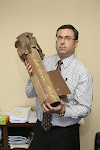It began as a small neighborhood shul and grew into a gorgeous edifice thanks to an anonymous quarter-million gift by a grateful worshipper
This is a synagogue whose status has grown over time. Founded in 1932 as a small, single-story building to serve the residents of the then distinctly German-Jewish new neighborhood of Rehavia, it included Yitzhak Ben-Zvi, the second president of Israel, among its worshippers. Indeed, Ben-Zvi marked his election to the presidency in 1952 by reading the weekly portion from the Prophets on the Sabbath immediately afterwards.
The entrance to HaNassi Synagogue. Photo: Jacob Solomon
One High Holiday service an American tourist turned up to find no available seats, whereupon the beadle indicated the one unoccupied place just by the president. On being called up to the Torah, the visitor expressed his gratitude in with a pledge of $250,000, which was ultimately used to complete the current magnificent building. When you visit, look for the plaque of the anonymous donor.
The original, distinguished congregation of leading Knesset figures, business people, and professionals of the first couple of generations of the State of Israel has long been shrinking with the aging of its founders, and the skyrocketing housing prices that pushed their children out of the district. But the seeds of the present, English-speaking-dominated membership were in place when the present three-storied structure opened its doors in 1972, and they formed the major part of the congregation by the 1990s.
Indeed, many were members of the Young Israel movement back in the States, which led to the President’s Synagogue adding “Young Israel” to its nomenclature in 1997.
Your impression of a Sabbath morning visit to President’s Synagogue will depend on which service you attend; downstairs (8:45) or upstairs (8:30).
The main upstairs sanctuary. Photo: Jacob Solomon
Whatever you choose, get there as soon as possible – seats run out.
With a younger crowd, downstairs runs faster with fewer frills, but includes a short delivery - in Hebrew - from Rabbi Berel Wein. Overall however it is a standard Israeli service.
With a younger crowd, downstairs runs faster with fewer frills, but includes a short delivery - in Hebrew - from Rabbi Berel Wein. Overall however it is a standard Israeli service.
By contrast, the sanctuary upstairs tends to attract a more mature, larger English speaking crowd, some of whom know Rabbi Wein from his previous rabbinical positions in Miami and the tri-state area. The service and repertoire are the more formal modes reminiscent of the “high church” style of American and Anglo-Jewry.
Modern, comfortable seating faces the illuminated Twelve Tribes of Israel-flanked ark. It is topped with two inspirational stained-glass windows, whose texts and illustrations show Biblical concern for creatures great and small by urging you send the mother bird away before taking her eggs in accordance with Deuteronomy 22:6-7.
The Twelve Tribes of Israel-surrounded ark of the main upstairs synagogue. Photo: Jacob Solomon
This environment forms the setting for Rabbi Wein’s upstairs discourse – in English – which is composed of weekly Torah-reading and topically-based inspirational insights.
One thing remains unsolved – the building’s façade.
It has two prominent parallel vertical strips, each divided into five. Possibly they represent the Ten Commandments. The 613 or so surrounding bricks (I didn’t have the patience to count them) appear to fit in with the view of leading exegete Saadia Gaon (892-942), that each one of the 613 mitzvot belongs to one of the heads of the Ten Commandments. The Ten Commandments would thus encapsulate the Torah, in short. Despite enquiries, no-one was able to either confirm or deny that interpretation.
Main Sabbath services are near sundown in the evening and at 6:45, 8:30, and 8:45 am in the morning. Weekday services happen at 6:45am (in the morning, and near sundown in the evening. At other times the synagogue may be locked.)
There is a wide range of shiurim, lectures, and activities; for details please consult www.bkhanassi.com.
To get there by public trannsport: Buses 7, 31, 32, 71, 72, 74, 74, and 78 to the last southward stop on King George Street. Walk southwards for two minutes and turn right and walk up Keren Kayemet Street for about three minutes. Turn left into Ussishkin Street, walk for another minute. The President’s Synagogue is on the left-hand side.

